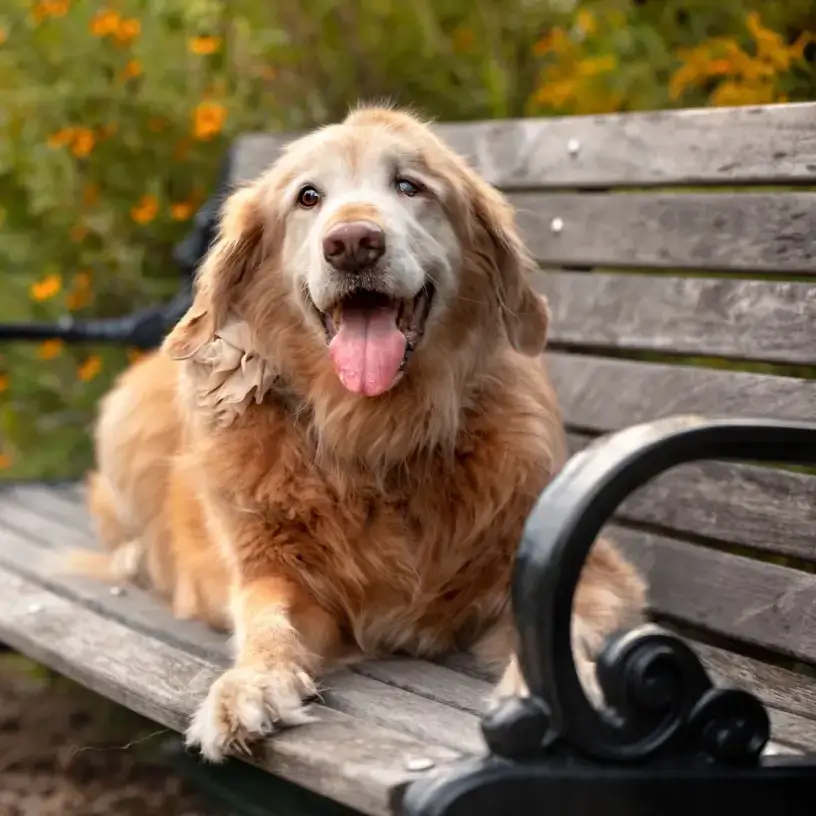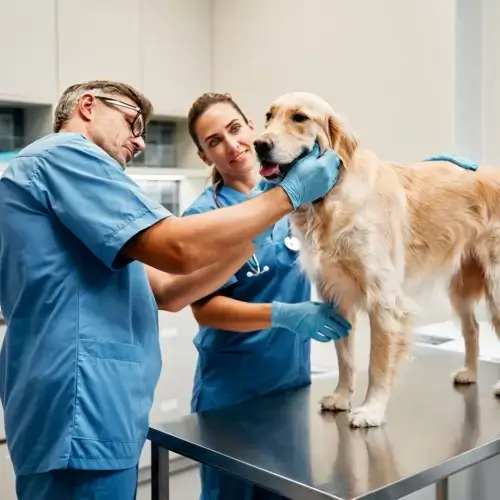Home / Compare Pet Insurance / Dog cancer
Dog cancer



Key takeaways
- Cancer in dogs is a heartbreaking reality, but taking preventative measures and being proactive about veterinary care can help reduce your dog’s cancer
- Early detection, proper care and a focus on quality of life can help your dog live a long, happy life after a cancer diagnosis.
- Pet insurance can help your dog get the best possible cancer treatment for their condition and reduce your financial strain, so it’s best that your dog is insured from an early age.
Cancer in dogs
Cancer in dogs is a common cause of death, especially in older dogs.1 It is a complex and emotional journey for pet owners, but early detection and appropriate treatment can improve your dog’s quality of life and extend it in many cases.
Like in humans, cancer in dogs occurs when cells grow uncontrollably, forming tumours that may be benign (non-cancerous) or malignant (cancerous). Malignant tumours can invade nearby tissues and spread (metastasise) to other parts of the body. Regular vet checkups, a healthy diet, and awareness of cancer symptoms can help you spot cancer early. If your dog is diagnosed with cancer, consult a veterinary oncologist to explore the best treatment options.
What causes dog cancer?
There is no single cause of cancer in dogs, but research has found several factors that may increase the risk of dog cancer.
Genetic predisposition
Genetics plays a huge part in whether your dog could get cancer.2 Some dog breeds may be more prone to cancer than others due to a combination of genes or a single gene. Pure breeds like those listed below are also more likely to get cancer than mixed-breed dogs:7
- Golden Retrievers and Boxers: High risk of lymphoma and hemangiosarcoma
- Bernese Mountain Dogs: High incidence of histiocytic sarcoma
- Scottish Terriers: Increased risk of bladder cancer.
Environmental factors
As pets live in the same environment as their owners, pets are often exposed to the same ecological hazards identified as risk factors for humans.1 These environmental hazards include:
- Tobacco smoke and air pollution which can increase the risk of lung cancer
- Herbicides, insecticides and pesticides (especially those used in agriculture) may increase the risk of bladder cancer
- Spending a lot of time outdoors may increase the likelihood of skin cancer, especially in light-coloured dogs.
- Toxins and carcinogens found in things like household cleaning products and some processed foods may contain harmful chemicals that can increase the risk of cancer.
Diet and obesity
- Diet plays a significant part in keeping your dog healthy.1 Ensuring your dog has good nutrition and a balanced diet can help your pet live a long, healthy life. Some studies suggest diets rich in omega-3 fatty acids, antioxidants, and lean protein may help reduce cancer risk.
- Highly processed, low-quality dog food with preservatives and additives may increase cancer risk over time due to its potential harmful effects on the body. These foods often lack essential nutrients, contributing to long-term health issues, including weakened immune function and an increased risk of diseases like cancer.
- Obesity in dogs can lead to various health issues, including chronic inflammation, which can increase the risk of conditions like arthritis and certain cancers. Overfeeding, especially with high-calorie food and treats, can lead to excess weight and put unnecessary stress on a dog’s organs and joints.
Hormonal factors
Some cancers, such as prostate or ovarian cancer, are linked to hormonal imbalances, especially in unspayed dogs over the age of 10.1
- Female dogs: Unspayed female dogs have a higher risk of mammary gland tumours, especially if they undergo multiple heat cycles before spaying.
- Male dogs: Unneutered male dogs have a higher risk of testicular cancer, especially when they’re over the age of 10.
Types of dog cancer
Common types of cancer in dogs include:3
- Lymphoma: Cancer of the lymphatic system
- Mast cell tumors: A common skin cancer
- Osteosarcoma: Bone cancer, particularly in large breeds
- Hemangiosarcoma: A highly aggressive cancer of the blood vessels
- Melanoma: Affects the skin, mouth or other mucous membranes
- Mammary gland tumours: Breast cancer, often seen in unspayed females.
Does pet insurance cover cancer in dogs?
 Yes, many pet insurance plans cover cancer treatments, but the level of cover depends on the provider, policy type and whether the cancer is considered a pre-existing condition. Comprehensive insurance plans or accident and illness plans typically cover diagnostics, surgery, chemotherapy, radiation and medications, while accident-only plans do not.
Yes, many pet insurance plans cover cancer treatments, but the level of cover depends on the provider, policy type and whether the cancer is considered a pre-existing condition. Comprehensive insurance plans or accident and illness plans typically cover diagnostics, surgery, chemotherapy, radiation and medications, while accident-only plans do not.
Depending on the form of cancer, cancer treatments can cost up to thousands of dollars. Pet insurance can significantly reduce financial strain. The biggest limitation is pre-existing conditions, meaning if your dog is diagnosed with cancer before enrolling, treatment won’t be covered.
To maximise cover, it’s best to get insurance while your dog is young and healthy, and to choose a plan with high reimbursement rates and lifetime cover. Some policies may include alternative treatments like acupuncture. However, routine checkups can be offered as an add-on if you regularly bring your dog for a health check.
Always compare different pet insurance providers and look for policies that offer high reimbursement rates, lifetime coverage and minimal restrictions on cancer treatments. Read the Product Disclosure Statement (PDS) and the Target Market Determination (TMD) to ensure you know what is and isn’t covered and that the product fits you.
What are the signs of cancer in dogs?
Symptoms of cancer can vary depending on the different types of cancer and its location.4 If you notice any of these symptoms, consult a veterinarian immediately.
General symptoms
- New growth of lumps and bumps on your dog’s body
- Unexplained or rapid weight loss
- Loss of appetite and decreased interest in food
- Always lethargic, reduced energy levels and increased sleep
- Persistent pain or discomfort and visible limping or sensitivity to touch
- Coughing or difficulty breathing.
Specific symptoms by cancer type
- Skin cancer (mast cell tumours, melanoma): Unusual sores, growths, or skin discolouration.
- Lymphoma: Swollen lymph nodes under the jaw, behind the knees or in the armpits.
- Bone cancer (osteosarcoma): Lameness, swelling or limb pain.
- Oral cancer: Bad breath, difficulty eating, drooling or bleeding from the mouth.
- Bladder cancer: Frequent urination, blood in urine or difficulty urinating.
- Hemangiosarcoma (internal cancer): Sudden collapse, pale gums or distended abdomen due to internal bleeding.
Preventing cancer in dogs
While cancer isn’t always preventable, there are things you can do to reduce your dog’s risk.5
Spaying and neutering
- Spaying your female dog before their first heat cycle can reduce the risk of mammary tumours by nearly 90%.
- Neutering can prevent testicular cancer and reduce the risk of prostate disease in male dogs.
Providing a healthy diet
- High-quality protein and healthy fats such as beef, lamb, and kangaroo can help support immune function.
- Antioxidants found in blueberries, carrots and leafy greens help neutralise harmful free radicals.
- Avoiding processed food with artificial preservatives, dyes and fillers may help prevent cancerous cells from developing.
- Omega-3 fatty acids found in fish oil and flaxseed are good for your dog’s coat, joints and digestive systems and may help reduce inflammation and slow tumour growth.
Reducing exposure to toxins
- Using natural or organic cleaning products can reduce exposure to harmful chemicals at home.
- Choose chemical-free lawns and avoid pesticides and herbicides linked to cancer.
- Limit sun exposure, especially in summer, and apply dog-safe sunscreen to light-skinned or short-haired dogs when outside on a hot day.
Maintaining a healthy weight
- Regular exercise and daily walks can strengthen your dog’s immune system and prevent obesity-related inflammation.
- Portion control and regular feeding times can help prevent excessive weight gain, which has been linked to increased cancer risk.
Regular veterinary checkups
- Routine blood tests and annual physical exams can detect early signs of cancer before symptoms appear.
- Any new growths or lumps and bumps should be evaluated by a veterinarian.
How long do dogs with cancer live?
Early detection of the tumour can improve the chances of successful treatment. However, the prognosis for dogs with cancer depends on multiple factors.6
Type of cancer
- Slow-growing cancers (e.g. some skin tumours) may allow dogs to live for years with proper treatment.
- Aggressive cancers (e.g. hemangiosarcoma) can be fatal within months, even with treatment.
Stage of diagnosis
- Early detection can increase the chances of successful treatment.
- Late-stage cancer often has a poor prognosis, as the cancer may have already spread.
Treatment options
- Surgery can be curative if the tumour has not spread and can be localised.
- Chemotherapy is known to have fewer side effects in dogs and can help slow cancer progression.
- Immunotherapy uses injections and vaccines to boost your dog’s immune system to fight the cancer cells.
- Radiation therapy may be used for tumours in areas where surgery is not an option.
- Palliative care focuses on improving quality of life, pain management and comfort for terminal cases.
Quality of life considerations
A cancer diagnosis can be overwhelming, and pet owners often struggle with how to move forward. The goal of cancer treatment is to ensure a good quality of life. Pet owners should monitor pain levels, appetite, energy and happiness. When a dog’s quality of life declines significantly, euthanasia may be the most compassionate option.
Meet our pet insurance expert, Adrian Taylor
As a General Insurance expert with over 13 years’ experience in financial services, Adrian Taylor knows that dogs and cats get themselves into all sorts of mischief. One part of Adrian’s work is to help empower consumers to understand how pet insurance can help save them from exorbitant vet bills when their pet gets injured or falls ill.
Want to know more about pet insurance?
1 petMD. Cancer in Dogs: Symptoms, Types and Treatment. Accessed February 2025.
2 DogCancer.com. Genetics in canine cancer. Accessed February 2025.
3 Blue Pearl Pet Hospital. Types of cancer in dogs. Accessed February 2025.
4 NC State University. What are common warning signs of cancer in pets? Accessed February 2025.
5 American Kennel Club (AKC). How to help your dog avoid cancer. Accessed February 2025.
6 BlueCross UK. Coping with cancer in dogs. Accessed February 2025.
7 DogCancer.com. Dog breeds prone to cancer. Accessed February 2025.

